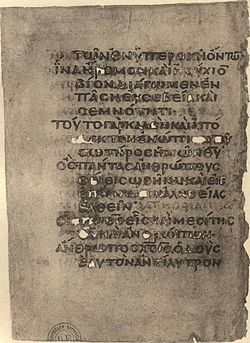
Timothy or Timothy of Ephesus was an early Christian evangelist and the first Christian bishop of Ephesus, who tradition relates died around the year AD 97.
Trophimus or Trophimus the Ephesian was a Christian who accompanied Paul during a part of his third missionary journey. He was with Paul in Jerusalem, and the Jews, supposing that the apostle had brought him into the temple, raised a tumult which resulted in Paul's imprisonment.. In writing to Timothy, the apostle comments that he left Trophimus in Miletus due to illness. This must refer to some event not noticed in the Acts.
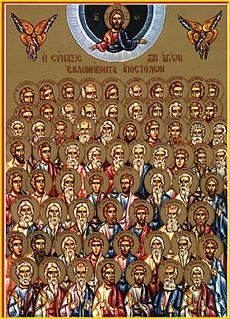
The seventy disciples or seventy-two disciples, known in the Eastern Christian traditions as the seventy apostles or seventy-twoapostles, were early emissaries of Jesus mentioned in the Gospel of Luke. The correct Greek terminology is evdomikonta (εβδομήκοντα) apostoli or evdomikonta mathetes.

Crescens was an individual who appears in the New Testament. He is traditionally considered one of the 72 disciples sent out by Jesus in Luke 10. He was a missionary in Galatia and became a companion of Paul. The name 'Crescens' is the present-active participle of the Latin word crescere, and means 'increasing'.

Tychicus Τυχικός/was an Asiatic Christian who, with Trophimus, accompanied the Apostle Paul on a part of his journey from Macedonia to Jerusalem. He is also alluded to have been with Paul in Rome, where the apostle sent him to Ephesus, probably for the purpose of building up and encouraging the church there. In the New Testament, he is mentioned five times.

Acts 14 is the fourteenth chapter of the Acts of the Apostles in the New Testament of the Christian Bible. It records the first missionary journey of Paul and Barnabas to Phrygia and Lycaonia. The book containing this chapter is anonymous but early Christian tradition uniformly affirmed that Luke composed this book as well as the Gospel of Luke.

Acts 16 is the sixteenth chapter of the Acts of the Apostles in the New Testament of the Christian Bible. It records the second missionary journey of Paul, together with Silas and Timothy. The book containing this chapter is anonymous but early Christian tradition uniformly affirmed that Luke composed this book as well as the Gospel of Luke.

Acts 18 is the eighteenth chapter of the Acts of the Apostles in the New Testament of the Christian Bible. It records the final part of the second missionary journey of Paul, together with Silas and Timothy, and the beginning of the third missionary journey. The book containing this chapter is anonymous, but early Christian tradition uniformly affirmed that Luke composed this book as well as the Gospel of Luke.

Acts 19 is the nineteenth chapter of the Acts of the Apostles in the New Testament of the Christian Bible. It records part of the third missionary journey of Paul. The author of the book containing this chapter is anonymous but early Christian tradition uniformly affirmed that Luke composed this book as well as the Gospel of Luke.
Acts 20 is the twentieth chapter of the Acts of the Apostles in the Christian New Testament of the Bible. It records the third missionary journey of Paul the Apostle. The book containing this chapter is anonymous, but early Christian tradition uniformly affirmed that Luke the Evangelist composed this book as well as the Gospel of Luke.

Acts 21 is the twenty-first chapter of the Acts of the Apostles in the New Testament of the Christian Bible. It records the end of Paul's third missionary journey and his arrival and reception in Jerusalem. The book containing this chapter is anonymous, but early Christian tradition uniformly affirmed that Luke composed this book as well as the Gospel of Luke.

Romans 16 is the sixteenth chapter of the Epistle to the Romans in the New Testament of the Christian Bible. It is authored by Paul the Apostle, while Paul was in Corinth in the mid 50s AD, with the help of a secretary (amanuensis), Tertius, who adds his own greeting in Romans 16:22. Chapter 16 contains Paul's personal recommendation, personal greetings, final admonition, grace, greetings from companions, identification of writer/amanuensis and blessing. The chapter is divided into 27 verses.
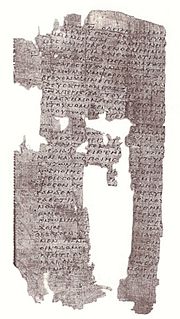
1 Corinthians 16 is the sixteenth and final chapter of the First Epistle to the Corinthians in the New Testament of the Christian Bible. It is authored by Paul the Apostle and Sosthenes in Ephesus, composed between 52–55 CE, and sent to the church in Corinth. This chapter contains the closing statements of the letter, with Paul's travel plans, final instructions, and greetings. Verse 8 confirms that Paul was in Ephesus when the letter was composed, and verse 21 confirms that the majority of the letter was scribed by an amanuensis.

2 Corinthians 1 is the first chapter of the Second Epistle to the Corinthians in the New Testament of the Christian Bible. It is authored by Paul the Apostle and Timothy in Macedonia in 55–56 CE.

Colossians 1 is the first chapter of the Epistle to the Colossians in the New Testament of the Christian Bible. Traditionally, it is believed to have been written for the churches in Colossae and Laodicea by Apostle Paul, with Timothy as his co-author, while he was in prison in Ephesus, although there are debatable claims that it is the work of a secondary imitator, or that it was written in Rome. This chapter contains the greeting, thanksgiving and prayer, followed by a "Christological Hymn" and the overall thesis of the letter.

Colossians 4 is the fourth chapter of the Epistle to the Colossians in the New Testament of the Christian Bible. Traditionally, it is believed to have been written for the churches in Colossae and Laodicea by Apostle Paul, with Timothy as his co-author, while he was in prison in Ephesus, although there are debatable claims that it is the work of a secondary imitator, or that it was written in Rome. This chapter contains the final exhortations and greetings.
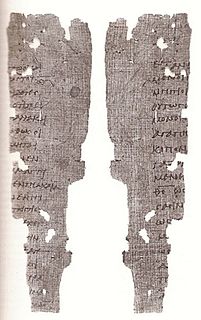
1 Thessalonians 1 is the first chapter of the First Epistle to the Thessalonians in the New Testament of the Christian Bible. It is authored by Paul the Apostle, likely written in Corinth in about 50-51 AD for the church in Thessalonica. This chapter contains the prescript and Paul's thanksgiving for the church.
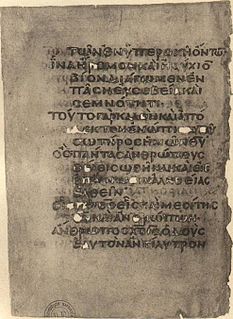
1 Timothy 1 is the first chapter of the First Epistle to Timothy in the New Testament of the Christian Bible. The author has been traditionally identified as Paul the Apostle since as early as AD 180, although most modern scholars consider the letter pseudepigraphical, perhaps written as late as the first half of the second century AD. This chapter contains the personal greeting (salutation), the exposition about the gospel and its counterfeit, Paul's personal experience of Christ and a charge as well as a warning to Timothy related to his call to the ministry.

2 Timothy 1 is the first chapter of the Second Epistle to Timothy in the New Testament of the Christian Bible. The letter is traditionally attributed to Paul the Apostle, the last one written in Rome before his death, addressed to Timothy. There are charges that it is the work of an anonymous follower, after Paul's death in the first century AD. This chapter contains an opening greeting, a personal story of Paul and Timothy, a description of the opponents they are facing.

Titus 3 is the third chapter of the Epistle to Titus in the New Testament of the Christian Bible. The letter is traditionally attributed to Paul the Apostle, sent from Nicopolis of Macedonia, addressed to Titus in Crete. There are charges that it is the work of an anonymous follower, after Paul's death in the first century AD. This chapter contains Paul's instruction for the church as a community with responsibilities in the public realm, towards the government and also towards individuals, concluded with some personal requests for Titus before the final benediction.
